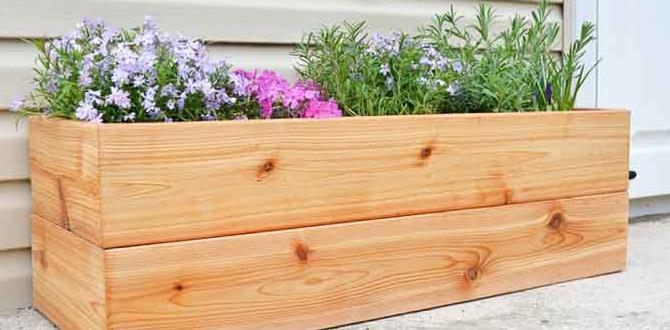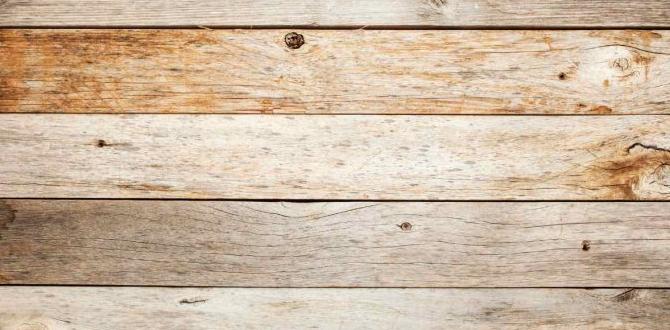Have you ever looked at a simple wooden box and wondered how it was made? Imagine creating your own beautiful wooden box. It can be easier than you think. Making a wooden box is not just rewarding; it can also be a fun project for you and your friends.
In this easy DIY guide, you’ll learn how to make a wooden box step by step. Whether you want to keep your treasures safe or give a special gift, a wooden box is perfect. Plus, when you make it yourself, it holds extra meaning.
Did you know that wooden boxes have been made for thousands of years? People used them to store valuable items and even food. So, why not join this ancient tradition? With a few simple tools and some creativity, you can craft something amazing. Let’s dive in and discover how to make a wooden box!
Table of Contents
How To Make A Wooden Box: Easy Diy Guide For Beginners

How to Make a Wooden Box: Easy DIY Guide
Making a wooden box can be a fun and rewarding project. First, gather materials like wood, nails, and glue. You will learn simple steps, from measuring and cutting to assembling the box. Choosing the right wood is crucial. Did you know that cedar and pine are excellent choices? Plus, crafting your box allows for personal touches, like painting or decorating. Dive in and create a useful item you can showcase or gift!Choosing the Right Type of Wood
Comparison of different wood types (pine, oak, plywood, etc.). Factors to consider for durability and aesthetics.Choosing the right wood is key for your box. Different types have unique features. Here’s a quick look:
- Pine: Soft, easy to work with, and less expensive.
- Oak: Strong and beautiful but a bit pricier.
- Plywood: Made from layers, strong, and good for sturdy boxes.
Think about durability and aesthetics. How will the box be used? Will it hold heavy items? If so, oak or plywood might be better. If it’s for simple storage, pine could be great. Choose wisely!
What is the best wood for making a box?
The best wood depends on your needs. Pine is great for beginners. Oak is perfect for strength and beauty. Plywood suits a sturdy design.
Planning Your Wooden Box Design
Key dimensions and design principles to consider. Sketching the box design and layout for cutting.Start by deciding how big you want your box to be. Think about what you’ll store inside. Here are some tips:
- Choose dimensions: Width, height, and depth should fit your needs.
- Design style: Will it be simple or decorated? Keep it balanced.
Next, sketch your box on paper. Draw a layout for your cuts. Make sure to mark where each piece goes. This will help you get it right when you start building. A good plan leads to a great box!
What should you consider when designing your wooden box?
Consider size, style, and how you’ll use it. Think about materials too. They affect strength and look.
Step-by-Step Cutting Instructions
Detailed instructions on measuring and cutting wood pieces. Safety tips for using cutting tools effectively.Start by measuring your wood pieces carefully. Use a tape measure to get the right lengths. Mark each cut with a pencil. This helps avoid mistakes.
Here are some smart tips for safety:
- Always wear safety goggles to guard your eyes.
- Keep your hands clear of the blades.
- Use a stable surface to cut on, like a table or workbench.
With the right measurements and safety rules, you can cut with confidence!
How to measure and cut wood safely?
To measure and cut wood safely, mark your wood clearly and use proper tools. Always keep your workspace clean and organized. This decreases the chances of accidents. Use clamps to hold wood in place for safer cuts.
Assembling Your Wooden Box
Techniques for joining pieces together securely (glue, screws). Tips for aligning and securing corners accurately.To build your wooden box, it’s key to join the pieces well. You can use glue or screws for strong connections. Glue is great for flat surfaces, while screws add a little extra strength, like your favorite superhero! Aligning corners is a piece of cake if you keep them neat. Use clamps to hold them steady while the glue dries or while you screw them in. Remember, a well-aligned box is less like a wobbly table and more like your best friend’s dance moves—smooth and precise!
| Joining Method | Best Use |
|---|---|
| Glue | Flat surfaces |
| Screws | Extra strength |
Sanding and Finishing Techniques
Importance of sanding for a smooth surface. Various finishing options (stain, paint, sealant) and their applications.Sanding is like giving your wooden box a spa day! It smooths out rough patches and makes the surface feel nice and soft. The magic happens when you use sandpaper, starting with a coarse grit and moving to a finer one. After sanding, you get to dress your box with some finishing touches. You can choose a stain for a warm vibe, paint for color fun, or a sealant to keep it safe from spills. Each option changes your box’s style and protects it. Here’s a quick look at your choices:
| Finish Type | Application |
|---|---|
| Stain | Adds color while showing wood grain |
| Paint | Offers bright colors for all-day fun |
| Sealant | Protects against water and scratches |
Personalizing Your Wooden Box
Ideas for customizing designs (burning, painting, decals). Suggestions for adding functional features (lids, compartments).Making your wooden box special is a fun adventure! You can burn cool designs into the wood or paint it in bright colors. Add stick-on decals for something extra snazzy. Don’t forget, compartmentalizing your box helps keep your treasures organized. Want a lid? It can keep your items safe from dust—or surprise attacks from pesky sibling thieves!
| Customization Ideas | Functional Features |
|---|---|
| Wood burning designs | Lids for keeping items safe |
| Bright paint colors | Compartments for organization |
| Fun decals | Handles for easy carrying |
Common Mistakes to Avoid
List of frequent pitfalls for DIY wooden box makers. Tips for troubleshooting issues during the project.Many beginners face common troubles while crafting wooden boxes. First, cutting the wood too short is a biggie. Remember, if it can’t hold your snacks, what’s the point? Misaligning corners is another mistake; they don’t usually fix themselves! Always double-check your measurements. And for glue spills? Well, let’s say they’re not a new design pattern! Keep your work area tidy, and mistakes will scatter away like a bad joke. Here’s a quick guide to these hiccups:
| Mistake | Tip |
|---|---|
| Cutting wood too short | Measure twice, cut once! |
| Misaligned corners | Use clamps to hold everything in place. |
| Glue spills | Wipe excess glue right away. |
Avoiding these pitfalls will keep your DIY spirit high and your boxes sturdy!
Where to Find Inspiration and Resources
Recommended books, websites, and video tutorials for further learning. Communities and forums for DIY enthusiasts to share ideas and tips.Looking to spark your creativity? Dive into books like “The Complete Manual of Woodworking.” It’s packed with tips and tricks! Websites such as Instructables or Pinterest offer endless DIY ideas. For video lovers, YouTube is gold for woodworking tutorials; you can watch someone mess up before your eyes—it’s like a DIY blooper reel!
Don’t forget to join communities and forums like Reddit’s r/woodworking. You can ask questions and share your projects. Remember, laughter is the best glue (unless you’re using wood glue!).
| Resources | Type |
|---|---|
| The Complete Manual of Woodworking | Book |
| Instructables | Website |
| YouTube Woodworking Tutorials | Video |
| r/woodworking on Reddit | Forum |
Conclusion
In conclusion, making a wooden box is simple and fun! Start by choosing the right wood and tools. Measure and cut carefully. Assemble your pieces using glue or nails. Sand down rough edges for a smooth finish. Now, you can decorate or paint your box as you like. So, grab your materials and get started on your own wooden box adventure!FAQs
What Materials Do I Need To Build A Simple Wooden Box?To build a simple wooden box, you need some wood pieces. You can use plywood or untreated pine. You’ll also need nails or screws to hold the wood together. Get some wood glue for extra strength and a sandpaper to smooth the edges. Finally, grab a hammer or a screwdriver to put it all together.
What Are The Best Tools For Crafting A Wooden Box At Home?To make a wooden box at home, you’ll need a few basic tools. First, use a saw to cut the wood pieces. A hammer helps you to nail the pieces together. You should also have sandpaper to smooth rough edges. Lastly, a measuring tape will help you get the right sizes for your box.
How Can I Ensure The Corners Of My Wooden Box Are Properly Joined?To make sure the corners of your wooden box are joined well, you can start by using wood glue. Apply the glue where the pieces meet and press them together. Then, use clamps to hold them in place while the glue dries. You can also add nails or screws for extra strength. Finally, check the corners to see if they are even and straight.
What Types Of Finishes Can I Apply To My Wooden Box For Durability And Aesthetics?You can use different finishes on your wooden box to make it last longer and look nice. A good choice is polyurethane. It protects the wood and gives it a shiny finish. You could also try oil finishes, like linseed oil, which bring out the wood’s natural color. Lastly, a wax finish can add a soft shine and make the box feel smooth.
Are There Any Design Templates Or Dimensions I Should Consider When Making A Wooden Box?Yes, there are some important things to think about when making a wooden box. First, decide what you will use the box for. This helps you pick the right size. You can use a simple template, like a square or rectangle. Common sizes are 6×6 inches or 12×8 inches, but you can make it any size you need!




